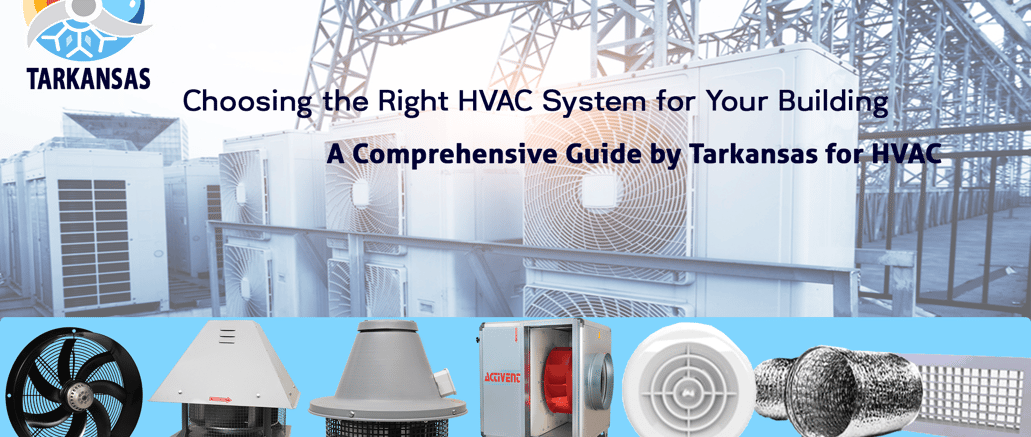Choosing the Right HVAC System for Your Building: A comprehensive Guide by Tarkansas for HVAC
When it comes to maintaining comfort in your Building, few things are as crucial as your HVAC (Heating, Ventilation, and Air Conditioning) system. It's the heart of your indoor climate control, ensuring you stay warm in winter and cool in summer. However, choosing the right HVAC system for your Building is not a decision to be taken lightly. It requires careful consideration of various factors to ensure you get the most efficient and cost-effective solution for your specific needs.
Eng. Hafeez , Sales & Marketing Engineering, TARKANSAS FOR HVAC
12/1/20234 min read


Types of HVAC Systems
The first step in selecting the right HVAC system is to understand the different types available. HVAC systems come in various configurations, each with its own set of advantages and limitations. Here are some common options offered by Tarkansas for HVAC:
1. Central Air Conditioning and Heating
Central HVAC systems are the most common choice for larger Buildings. They consist of a central furnace or air handler connected to a network of ducts that distribute heated or cooled air to different rooms through vents. Central systems can use either natural gas or electricity to generate heat and cool air. They provide consistent temperature control throughout the entire house.
Advantages:
- Effective for larger Buildings.
- Even temperature distribution.
- High energy efficiency when properly maintained.
Considerations:
- Installation can be costly, especially if ductwork is needed.
- Regular maintenance is essential for efficiency.
2. Heat Pumps
Heat pumps are versatile HVAC systems that can both heat and cool your Building. They work by transferring heat from one place to another, extracting heat from the outside air to warm your Building during winter and reversing the process to cool it during summer. Heat pumps are highly energy-efficient and eco-friendly.
Advantages:
- Efficient heating and cooling in moderate climates.
- Lower operating costs.
- Reduced carbon footprint.
Considerations:
- Less effective in extremely cold climates.
- May require a backup heating source in colder regions.
3. Ductless Mini-Splits
Ductless mini-split systems offer flexibility and zoned heating and cooling. These systems consist of an outdoor unit connected to one or more indoor air handlers. Each indoor unit is controlled independently, allowing you to adjust the temperature in different rooms or zones as needed.
Advantages:
- Zoned heating and cooling for energy savings.
- Easy installation without ductwork.
- Great for Building additions or retrofitting.
Considerations:
- Higher upfront cost per indoor unit.
- Regular cleaning and maintenance required for optimal performance.
4. Window or Wall Air Conditioners
Window or wall-mounted air conditioners are suitable for smaller spaces or single rooms. They are cost-effective and easy to install, making them a popular choice for apartments and small Buildings.
Advantages:
- Affordable.
- Easy installation.
- Ideal for small spaces.
Considerations:
- Limited to cooling only.
- May not be aesthetically pleasing.
5. Geothermal Heat Pumps
Geothermal heat pumps harness the stable temperature of the Earth's crust to provide highly efficient heating and cooling. They use a loop of underground pipes filled with a heat transfer fluid to exchange heat with the ground. While the upfront costs are higher, geothermal systems offer substantial long-term energy savings.
Advantages:
- Exceptional energy efficiency.
- Minimal environmental impact.
- Long lifespan.
Considerations:
- High initial installation cost.
- Requires sufficient outdoor space for the ground loop.
Sizing and Efficiency
Once you've identified the type of HVAC system that suits your needs, the next crucial step is to determine the appropriate size and efficiency rating. Proper sizing ensures that your system can efficiently heat or cool your Building without wasting energy. Efficiency ratings, on the other hand, indicate how well the system converts energy into temperature control.
Sizing Your HVAC System
Sizing your HVAC system involves calculating the heating and cooling load of your Building. Factors that influence this calculation include:
- Square footage of your Building.
- Climate and local weather conditions.
- Insulation levels.
- Number and size of windows.
- Ceiling height.
- Occupancy patterns.
It's essential to work with an experienced HVAC professional from Tarkansas for HVAC who can perform a Manual J load calculation to determine the correct system size. Oversizing or undersizing your HVAC system can lead to comfort issues and increased energy bills.
Efficiency Ratings
Efficiency ratings help you understand how well an HVAC system converts energy into cooling or heating. Look for the following efficiency ratings when choosing a system, all of which are explained in detail by our experts at Tarkansas for HVAC:
- SEER (Seasonal Energy Efficiency Ratio): Measures the cooling efficiency of air conditioners and heat pumps. Higher SEER ratings indicate greater energy efficiency.
- HSPF (Heating Seasonal Performance Factor): Evaluates the heating efficiency of heat pumps. Higher HSPF ratings indicate greater heating efficiency.
- AFUE (Annual Fuel Utilization Efficiency): Measures the efficiency of gas or oil furnaces. A higher AFUE rating means better energy efficiency.
- EER (Energy Efficiency Ratio): Similar to SEER, but measures cooling efficiency at higher temperatures.
Choosing a system with high efficiency ratings may have a higher upfront cost, but it can result in significant long-term energy savings. Additionally, many energy-efficient HVAC systems may qualify for rebates or tax incentives, further reducing your overall investment.
Budget Considerations
While finding the perfect HVAC system for your Building is essential, it's also crucial to consider your budget. HVAC systems come in a wide range of price points, and your budget will play a significant role in your final decision. Here are some budget considerations to keep in mind with the expert guidance of Tarkansas for HVAC:
Initial Costs
The initial cost of the HVAC system includes the price of the equipment itself, installation, and any necessary ductwork or modifications. Central HVAC systems and geothermal heat pumps tend to have higher upfront costs compared to ductless mini-splits or window units.
Operating Costs
Operating costs include energy bills, maintenance, and repairs over the life of the system. Energy-efficient systems from Tarkansas for HVAC typically have lower operating costs, which can offset their higher initial price. Consider the long-term savings when evaluating your budget.
Financing Options
Many HVAC manufacturers and dealers, including Tarkansas for HVAC, offer financing options to help you spread the cost of your new system over time. Explore these options to make a high-efficiency system more affordable upfront.
Maintenance and Repairs
Don't forget to budget for routine maintenance and potential repairs. Regular HVAC maintenance by our skilled technicians is essential for keeping your system efficient and prolonging its lifespan. Set aside funds for annual check-ups and any unexpected repairs.
Conclusion
Choosing the right HVAC system for your Building is a significant decision that requires careful consideration of your specific needs, budget, and efficiency requirements. Whether you opt for a central air conditioning and heating system, a heat pump, ductless mini-splits, or any other type, proper sizing and efficiency ratings are critical to ensuring optimal performance and energy savings.
At Tarkansas for HVAC, we understand the complexities of HVAC systems, and our experts are here to guide you every step of the way. Working with a reputable HVAC professional is key to making an informed decision. They can perform load calculations, recommend the most suitable system, and help you navigate financing options and potential rebates. Remember that investing in an energy-efficient HVAC system not only enhances your comfort but also reduces your environmental impact and long-term operating costs.
In the end, the right HVAC system from Tarkansas for HVAC will provide you with year-round comfort, improved indoor air quality, and peace of mind knowing that you've made a wise investment in your Building's overall efficiency and value.
